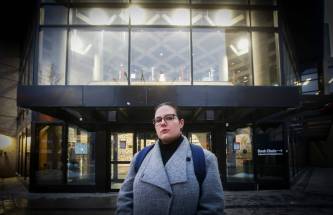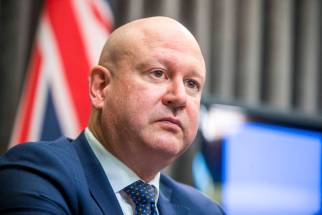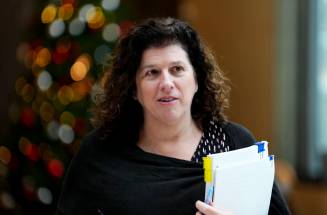School division report raises alarm over surging student absence rate
Read this article for free:
or
Already have an account? Log in here »
To continue reading, please subscribe:
Monthly Digital Subscription
$0 for the first 4 weeks*
- Enjoy unlimited reading on winnipegfreepress.com
- Read the E-Edition, our digital replica newspaper
- Access News Break, our award-winning app
- Play interactive puzzles
*No charge for 4 weeks then price increases to the regular rate of $19.00 plus GST every four weeks. Offer available to new and qualified returning subscribers only. Cancel any time.
Monthly Digital Subscription
$4.75/week*
- Enjoy unlimited reading on winnipegfreepress.com
- Read the E-Edition, our digital replica newspaper
- Access News Break, our award-winning app
- Play interactive puzzles
*Billed as $19 plus GST every four weeks. Cancel any time.
To continue reading, please subscribe:
Add Free Press access to your Brandon Sun subscription for only an additional
$1 for the first 4 weeks*
*Your next subscription payment will increase by $1.00 and you will be charged $16.99 plus GST for four weeks. After four weeks, your payment will increase to $23.99 plus GST every four weeks.
Read unlimited articles for free today:
or
Already have an account? Log in here »
Hey there, time traveller!
This article was published 13/12/2022 (1097 days ago), so information in it may no longer be current.
“Chronically absent” kindergarten and Grade 1 students now outnumber those who attend classes regularly in one Winnipeg school division.
The Louis Riel School Division published a new report that outlines the alarming toll COVID-19 and other respiratory viruses continue to have on Manitoba’s K-12 buildings this week.
The interactive project, which showcases current and historical fall student absence rates, shows overall non-attendance has surged beyond record-breaking levels in 2020 and 2021.
While the number of students who miss partial or entire school days on a regular basis is up across all grades, there are particularly stark trends amongst the division’s youngest pupils.
“So often, an absence, absences — it can all get away from you,” said superintendent Christian Michalik, who oversees the education of about 15,500 public school students.
“The longer you’re away, the more difficult it is to find one’s way back into community, one’s way back to the learning journey everyone else is on. It requires tremendous work and a tremendous collective effort (to break these patterns).”
“The longer you’re away, the more difficult it is to find one’s way back into community, one’s way back to the learning journey everyone else is on.”–Christian Michalik
Michalik said this reality warrants significant investments in public education to ensure small class sizes, adequate staffing levels and other resources can support consistent learning in the coming year and beyond.
So far this year, the overall absence rate — which accounts for the period of September, October and November — is 12 per cent. The average autumn absence rate for the five academic years predating the COVID-19 pandemic was less than seven per cent.
Chronic absenteeism is defined as non-attendance for 10 per cent. Across Louis Riel’s 40 schools, the number of students who have missed more than that percentage of the academic year to date is up 15 per cent from pre-pandemic periods.
If a student misses upwards of 20 per cent of all instructional days, they are considered “severely chronically absent.”
More than half of students in kindergarten and Grade 1 and nearly half of students in Grade 12 have missed more than 10 per cent of the 2022/23 school year.
The former is the equivalent of missing about a month of the 2022-23 academic year, given the province has allotted 193 days on the calendar. The latter is the equivalent of being absent for two full cumulative months of instruction.
While teachers monitor attendance daily, these thresholds prompt a further probe into why a child is not at school, exploration of strategies to re-engage them in traditional schooling, if need be, and possible contact with community services.
The president of the Louis Riel Teachers’ Association said significant student and staff non-attendance, much of it tied to illness, is contributing to workloads that have skyrocketed since March 2020.
“An absent student requires special considerations. Multiple absent students impact learning plans for the class as a whole,” union leader Marcela Cabezas said.
“An absent student requires special considerations. Multiple absent students impact learning plans for the class as a whole.”–Marcela Cabezas
About 23 per cent of all kindergartners missed enough instructional time to be classified as chronically or severely chronically absent between 2014-15 and 2018-19. To date in 2022-23, that figure is 54 per cent.
The chronic absence rate spiked 31 per cent among Grade 1 children during that time, followed by increases of 27 and 23 per cent among their peers in grades 2 and 3, respectively.
Chronic attendance problems have worsened in communities that have struggled the most throughout the pandemic due to socioeconomic factors, according to the superintendent.
Michalik also acknowledged older students have typically missed more school than their younger peers in the past, which is why there is likely such a drastic surge in absenteeism in K-3 classrooms.
More than 7,000 students have missed more than 10 per cent of the school year in 2022/23, up 20 per cent from chronic absenteeism rates seen in pre-pandemic years.
While noting he is far from a virologist, Michalik said the illnesses circulating have also likely affected elementary students’ young immune systems more than others.
Analyzing the data and sharing it with community members was the first step, Michalik added, noting it’s now time to investigate the proper pedagogical response and ensure schools are being flexible, offering personalized learning, and maintaining welcoming environments for students to return to.
Young students, in particular, are missing out on curriculum content and socialization opportunities — the results of which will “reverberate for years,” said Cabezas, a high school Spanish and English teacher.
At the same time, the union leader said low morale and burnout are serious worries in staff rooms, as teams grapple with recovery learning in all areas while education funding fails to keep up with inflation.
A spokesperson for Manitoba Education said the department continues to work closely with public health officials to monitor seasonal respiratory illness rates and encourage school community members to get immunized and stay home when symptomatic.
“School officials know their communities best. Those with increased rates of absenteeism among students and staff are encouraged to reach out to their local public health office,” the spokesperson wrote in an email.
The province recently stopped reporting school outbreaks, following the discontinuation of its dashboard of active COVID-19 cases in K-12 communities.
Asked about whether the division will reintroduce a mask mandate, Michalik said LRSD would not have the power to enforce such a measure if it is not backed by a public health order. The school division leader said senior administrators will be discussing a renewed emphasis on strongly recommending masks in the coming days.
Louis Riel is the sole district that publicly reports its absenteeism rates.
maggie.macintosh@freepress.mb.ca
Twitter: @macintoshmaggie
MIKE DEAL / WINNIPEG FREE PRESS FILES
While the number of students who miss partial or entire school days on a regular basis is up across all grades, there are particularly stark trends amongst the division’s youngest pupils.

Maggie Macintosh reports on education for the Winnipeg Free Press. Funding for the Free Press education reporter comes from the Government of Canada through the Local Journalism Initiative.
Our newsroom depends on a growing audience of readers to power our journalism. If you are not a paid reader, please consider becoming a subscriber.
Our newsroom depends on its audience of readers to power our journalism. Thank you for your support.









